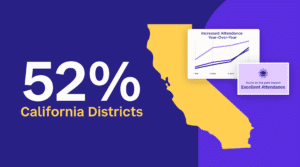
Featured Resource
Why Over Half of California School Districts Trust SchoolStatus
Read More >Join Mission: Attendance to reduce chronic absenteeism in 2025-26! >> Learn How <<





This post is part of TeachBoost’s new series called “From Vision to Reality: Pulling the Right Levers for Transformational Instructional Leadership.” Check out all the posts in our series, then subscribe to our blog to have posts delivered to your inbox as we publish new pieces.
{{cta(‘417de94b-2f71-4123-a807-1f4438f581c5′,’justifycenter’)}}
Now that you’ve laid the groundwork for transformational instructional leadership, you’re ready for the next step: getting the work done.
Schools and districts employ various strategies for prioritizing observations and feedback. In this post and the next few that follow, instructional leaders reflect on the four most important steps all educators must take to turn their vision into a reality.
When it comes to educator development, frequent, meaningful feedback matters. It matters to teachers, administrators, and kids, and it has far-reaching effects, from building community to driving instructional decision-making to increasing student achievement.
The only way to deliver frequent, meaningful feedback is to get into classrooms regularly. For a majority of the districts we support, “frequent” means every day. It’s the cornerstone of many transformational instructional leadership programs: “Frequent classroom observations are an important and integral part of our teacher development work,” shares Laura Vilines, Chief Academic Officer at STEM Preparatory Academy in Tennessee.
While time is often a school leader’s scarcest resource, “…in our line of work, interruptions are inevitable—we can expect them, so they shouldn’t be an excuse,” says The Principal Center’s Justin Baeder.
Leadership teams must devise effective time management strategies to be sure educators have the bandwidth to get into classrooms on a daily or near-daily basis. Check out the Follow-up Activity at the end of this section for a simple daily visit strategy that any school leader can try out.
Vilines worked with school leaders to develop a manageable plan for high-frequency classroom visits:
To help school leaders prioritize their work, we take a differentiated, proficiency-based approach to observations. Our new teachers, for example, are observed every week, then coached in weekly meetings. More experienced teachers are put on a different schedule. We look at all of our data on teacher performance quarterly to understand where teachers are in terms of growth. That helps us make adjustments to the frequency of feedback and coaching.
For many teachers, regular visits may be unsettling at first—don’t forget, some educators still report hosting their principals only once or twice a year. However, our leaders have found that the more frequently they visit classrooms, the more their teachers welcome them in.
This means that you are more likely to observe authentic teaching and learning, rather than an overly-prepared lesson delivered by a nervous teacher. “Teachers are comfortable with our presence because it’s always what we’ve done,” says Gillian Quinn, school leader and founder of KIPP Northeast College Prep in Houston.
Adapted from Justin Baeder’s original guest post.
Visit 10% of classrooms every day, and in two weeks you’ll have seen them all!
Here’s how:
Divide by 10 the number of teachers you need to observe. For most people, 10% equates to 2–5 classrooms per day.
Depending on how frequently you get interrupted by emergencies—for example, if you’re the assistant principal who responds to all discipline calls from teachers—adjust your 10% by a multiplier between 1.5 and 3.
Take the multiplied number and identify that same amount of time slots on your calendar, each about 10 minutes in length, in which you can walk to, observe, and walk from a classroom. For example, if you need to visit 4 classrooms a day, carve out 6–12 10-minute time slots.
Treat these as real appointments with yourself until you’ve hit your target for the day—and don’t let anything but a true emergency pull you away.
Stick to the schedule.
If you don’t get interrupted, you may find that you finish your walkthroughs by 9:30 a.m. On other days, you may just barely get them all in. Either way, when you’ve hit your target, you can re-allocate the remaining time slots you’ve set aside.
 SchoolStatusSchoolStatus gives educators the clarity and tools they need to get students to class and keep them moving ahead. Through our integrated suite of data-driven products, we help districts spot attendance patterns early, reach families in ways that work for them, and support teacher growth with meaningful feedback. Our solutions include automated attendance interventions, multi-channel family communications in 130+ languages, educator development and coaching, streamlined digital workflows, and engaging school websites. Serving over 22 million students across thousands of districts in all 50 states, SchoolStatus helps teachers and staff see what matters, act with speed, and stay focused on students.
SchoolStatusSchoolStatus gives educators the clarity and tools they need to get students to class and keep them moving ahead. Through our integrated suite of data-driven products, we help districts spot attendance patterns early, reach families in ways that work for them, and support teacher growth with meaningful feedback. Our solutions include automated attendance interventions, multi-channel family communications in 130+ languages, educator development and coaching, streamlined digital workflows, and engaging school websites. Serving over 22 million students across thousands of districts in all 50 states, SchoolStatus helps teachers and staff see what matters, act with speed, and stay focused on students.
News, articles, and tips for meeting your district’s goals—delivered to your inbox.






